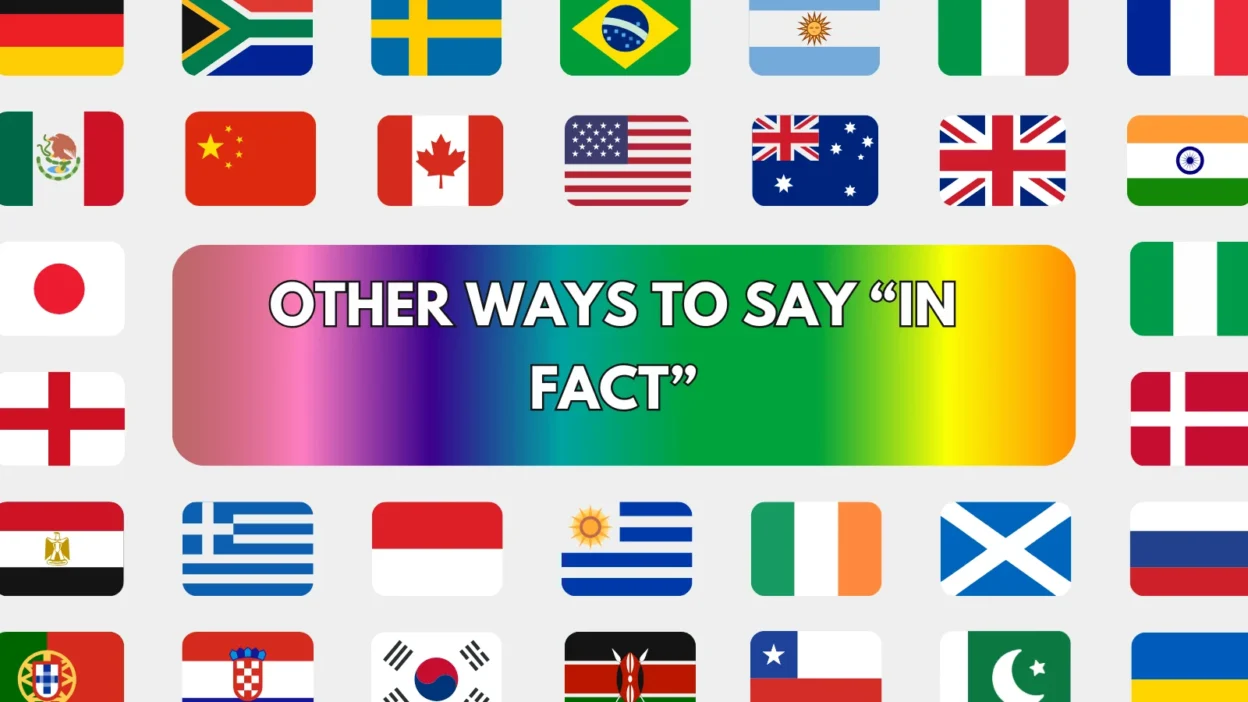The phrase “in fact” is commonly used to add emphasis, confirm a previous statement, or introduce a surprising truth. It helps make your writing or speech more convincing and informative. However, overusing it can make your language repetitive or flat. To sound more engaging, polished, or nuanced, it’s helpful to know a variety of alternatives.
Here are 25 powerful and professional ways to say “in fact”, with explanations and examples to help you use them smoothly in your writing or speaking.
1. Actually
Meaning:
Used to correct, clarify, or add emphasis to a statement.
Detailed Explanation:
“Actually” works well when you’re revealing something unexpected or slightly contrary to what’s assumed. It’s versatile in tone.
Scenario Example:
Actually, I’ve already completed that report.
Best Use:
Casual speech, corrections, polite disagreements.
Tone:
Neutral to slightly assertive.
2. Indeed
Meaning:
Used to confirm or strengthen a point.
Detailed Explanation:
“Indeed” adds weight or elegance to a statement, especially in formal writing or polite conversation.
Scenario Example:
He is indeed one of our most valuable team members.
Best Use:
Formal writing, speeches, reports.
Tone:
Formal, confident.
3. As a matter of fact
Meaning:
Used to confirm something, often in response to a doubt.
Detailed Explanation:
This phrase feels conversational and slightly assertive, often used to introduce facts or corrections.
Scenario Example:
As a matter of fact, I spoke to her this morning.
Best Use:
Conversation, persuasive writing.
Tone:
Confident, informative.
4. To tell you the truth
Meaning:
Used when offering a sincere or surprising statement.
Detailed Explanation:
Adds honesty and can signal a shift in tone or reveal.
Scenario Example:
To tell you the truth, I wasn’t expecting such a quick response.
Best Use:
Personal conversation, opinion sharing.
Tone:
Honest, casual.
5. The truth is
Meaning:
Emphasizes the reality of a situation.
Detailed Explanation:
This sets the stage for a fact or opinion that might differ from assumptions.
Scenario Example:
The truth is, we don’t have enough data to proceed.
Best Use:
Honest communication, reports.
Tone:
Direct, sincere.
6. In reality
Meaning:
Describes what’s really happening versus what’s perceived.
Detailed Explanation:
Useful for correcting misconceptions or presenting the real situation.
Scenario Example:
In reality, very few people follow that rule.
Best Use:
Analytical writing, educational content.
Tone:
Objective, explanatory.
7. Essentially
Meaning:
Highlights the core truth of something.
Detailed Explanation:
Great for simplifying complex ideas or emphasizing the most important detail.
Scenario Example:
Essentially, this is a budgeting issue, not a staffing one.
Best Use:
Professional emails, summaries.
Tone:
Concise, thoughtful.
8. In truth
Meaning:
Expresses honesty or the underlying reality.
Detailed Explanation:
Similar to “in fact,” but adds a slightly poetic or emotional touch.
Scenario Example:
In truth, we’ve been struggling to meet deadlines.
Best Use:
Reflective writing, serious conversations.
Tone:
Sincere, reflective.
9. Truly
Meaning:
Affirms something with sincerity or strength.
Detailed Explanation:
Often used to strengthen a positive or emotional statement.
Scenario Example:
She is truly one of the best designers we’ve worked with.
Best Use:
Appreciation, reviews, persuasive writing.
Tone:
Positive, heartfelt.
10. Actually speaking
Meaning:
Clarifies the real situation or facts.
Detailed Explanation:
Similar to “actually,” but slightly more formal or explanatory.
Scenario Example:
Actually speaking, we’ve already made the necessary updates.
Best Use:
Discussions, soft corrections.
Tone:
Clarifying, smooth.
11. Certainly
Meaning:
Used to strongly affirm a point or fact.
Detailed Explanation:
Adds confidence to statements, often used in agreement or confirmation.
Scenario Example:
He is certainly qualified for the role.
Best Use:
Professional writing, formal speech.
Tone:
Confident, strong.
12. Without a doubt
Meaning:
Used to stress that something is absolutely true.
Detailed Explanation:
Adds intensity and confidence to a factual statement.
Scenario Example:
She is without a doubt the most consistent performer on the team.
Best Use:
Persuasive writing, testimonials.
Tone:
Bold, assuring.
13. Evidently
Meaning:
Clearly or obviously true.
Detailed Explanation:
Used when facts or behavior support the claim.
Scenario Example:
Evidently, the policy isn’t being followed properly.
Best Use:
Reports, analyses.
Tone:
Observational, analytical.
14. To be clear
Meaning:
Used to clarify or emphasize a point.
Detailed Explanation:
Signals a direct and transparent truth — often useful in discussions or instructions.
Scenario Example:
To be clear, this deadline cannot be extended.
Best Use:
Emails, meetings.
Tone:
Direct, informative.
15. It’s worth noting
Meaning:
Introduces a relevant and often surprising fact.
Detailed Explanation:
Helps guide attention toward an important or overlooked detail.
Scenario Example:
It’s worth noting that our costs have decreased by 15%.
Best Use:
Presentations, reports.
Tone:
Informative, subtle.
16. Believe it or not
Meaning:
Introduces a surprising or hard-to-believe fact.
Detailed Explanation:
Adds dramatic or humorous flair while emphasizing truth.
Scenario Example:
Believe it or not, he completed the task in just two hours.
Best Use:
Storytelling, casual writing.
Tone:
Playful, dramatic.
17. Clearly
Meaning:
Emphasizes that something is obvious or well-supported.
Detailed Explanation:
Great for stating facts that are hard to dispute.
Scenario Example:
Clearly, the new strategy is working better.
Best Use:
Argumentative writing, analysis.
Tone:
Confident, logical.
18. It turns out
Meaning:
Reveals a new fact or result.
Detailed Explanation:
Often used to share something unexpected that has just become known.
Scenario Example:
It turns out the issue was with the server configuration.
Best Use:
Storytelling, updates.
Tone:
Revealing, neutral.
19. Just so you know
Meaning:
Introduces a fact for awareness or emphasis.
Detailed Explanation:
A casual way to bring something to someone’s attention.
Scenario Example:
Just so you know, the meeting has been moved to 3 PM.
Best Use:
Internal chats, informal reminders.
Tone:
Casual, conversational.
20. Notably
Meaning:
Highlights an important or striking fact.
Detailed Explanation:
A sophisticated way to point out a key detail.
Scenario Example:
Notably, the second campaign generated double the revenue.
Best Use:
Reports, formal writing.
Tone:
Professional, refined.
21. Needless to say
Meaning:
Used when something is so obvious it almost doesn’t need to be said.
Detailed Explanation:
Adds emphasis while acknowledging that the truth is self-evident.
Scenario Example:
Needless to say, we were all impressed by her performance.
Best Use:
Opinion pieces, emphasis.
Tone:
Assertive, confident.
22. Undeniably
Meaning:
Cannot be denied; unquestionably true.
Detailed Explanation:
Strongly affirms the validity of a statement or fact.
Scenario Example:
She is undeniably a leader in this field.
Best Use:
Persuasive writing, recommendations.
Tone:
Powerful, formal.
23. Put simply
Meaning:
Boils down a complex idea into a basic truth.
Detailed Explanation:
Useful when simplifying explanations for clarity.
Scenario Example:
Put simply, we’re spending more than we’re earning.
Best Use:
Explanations, executive summaries.
Tone:
Direct, clear.
24. To be honest
Meaning:
Adds a personal or sincere truth to the conversation.
Detailed Explanation:
More informal, often used when expressing personal insight or feelings.
Scenario Example:
To be honest, I think we should have handled that differently.
Best Use:
Casual conversation, opinions.
Tone:
Candid, emotional.
25. The fact of the matter is
Meaning:
States an undeniable truth or reality.
Detailed Explanation:
Often used to clarify or emphasize a foundational truth.
Scenario Example:
The fact of the matter is, we’re not meeting our goals yet.
Best Use:
Firm discussions, analytical writing.
Tone:
Strong, assertive.
Conclusion
Using “in fact” is a great way to emphasize or clarify a point, but having a range of alternatives allows you to sound more polished, persuasive, and natural. Whether you’re writing formally or casually, these 25 variations give you the tools to match any tone or audience with ease.




